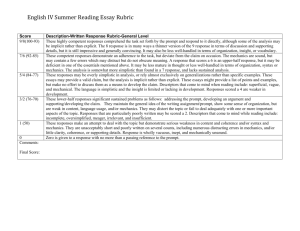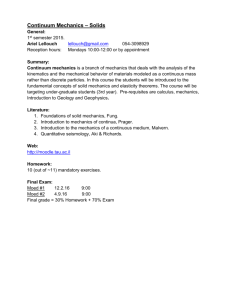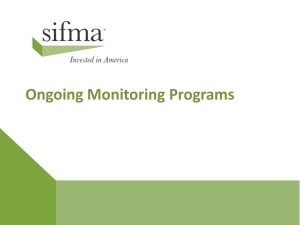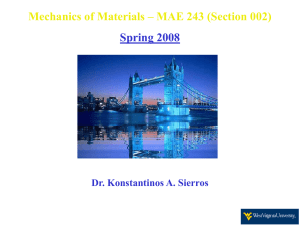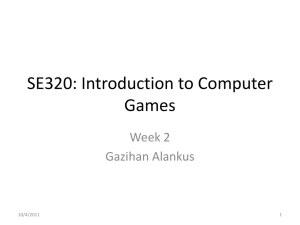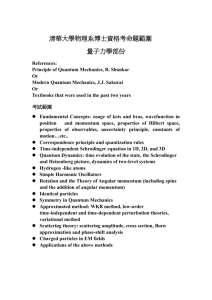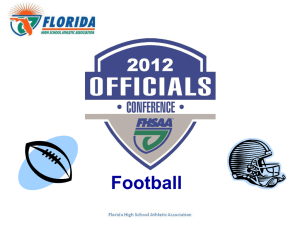A success story in high school physics education
advertisement
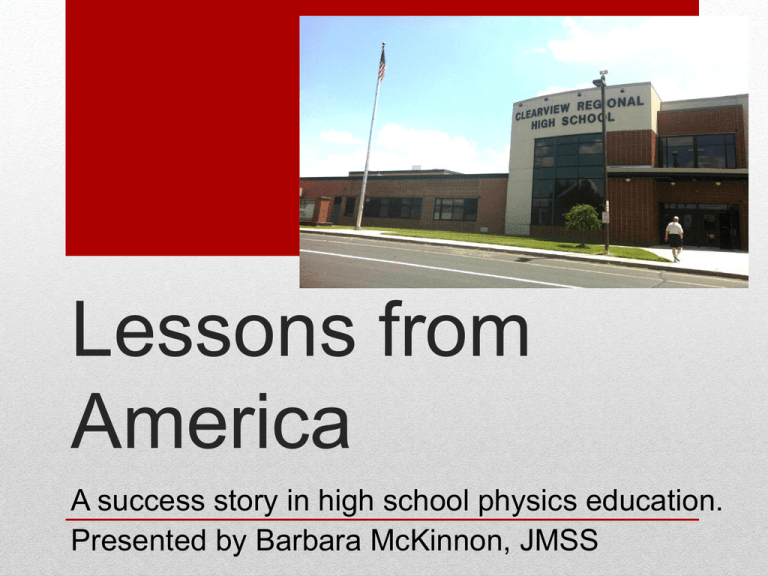
Lessons from America A success story in high school physics education. Presented by Barbara McKinnon, JMSS 1. What is Modeling Instruction? 2. What is successful about Modeling Instruction? 3. What are the implications for the Australian curriculum? • • • • • • • • • • • • Scientific Thinking Constant Velocity Constant Acceleration Force causing change in velocity Force as an interaction Force diagrams and net force Relationship between force and acceleration Friction 2D motion Energy (storage and transfer via working, heating, radiating) Circular motion Impulsive forces (conservation of linear momentum) Modeling Mechanics Curriculum Mechanics Modeling Workshops 90 hours of professional development consisting of • intensive immersion in the mechanics modeling curriculum and pedagogy • discussion of research literature • building connections with the modeling teaching community Why is a new pedagogy needed? - Traditional instruction does not effectively address misconceptions - For many students, traditional instruction is not successful in teaching conceptual understanding or scientific reasoning What is modeling? Students actively engaged in 1. construction of a phenomenological model based upon their own observation and experimentation 2. deployment of the model in problem solving and testing 3. model breaking What the students say about modeling Essential Tools 1. Multiple representations 2. Small whiteboards to facilitate presentation of ideas 3. Socratic questioning Outcomes Effective scientific reasoners who have advanced problem solving skills. How is this measured? 1. Performance on conceptual assessment instruments such as Force Concept Inventory 2. Results on conventional statewide tests. 3. Retention of students in Science 10000 students 170 teachers Hestenes, D. 2000 Findings of the modeling workshop project (1994 – 2000). Final report submitted to the National Science Foundation Hake, R. 1998 Interactive-engagement versus traditional methods: a six thousand student survey of mechanics test data for introductory physics courses. Am. J. Phys. 66(1) 64-71. Hake, R. 1998 Interactive-engagement versus traditional methods: a six thousand student survey of mechanics test data for introductory physics courses. Am. J. Phys. 66(1) 64-71. Modeling curricula have been written for • Chemistry • Biology • Humanities – English and History Is modeling only for Physics? Modeling is about creating multiple connections between the physical system and mental model. Symbolic Representations Verbal Algebraic Physical System Mental Model Diagrammatic Graphical Points to consider Modeling takes more time, can’t cover as much curriculum. The Physics First experience: • • • Students in Year 9 spend a year doing Physics using modeling Improves outcomes in Chemistry and Biology Increases retention in Science Don’t have to teach everything using modeling for procedural benefit to be retained. Outcomes in the USA Using a modeling approach find that • Students are engaged • Students improve their reasoning through communication of their scientific thinking and by debating with peers. • Students achieve a deeper conceptual understanding and become better problem solvers • Students increase their learner confidence by building their own conceptual framework. • Both girls and boys respond well to approach. Modeling instruction is a demonstration of the power of teaching informed by education research. • Modeling has been found to be most successfully delivered when teacher has attended a three week workshop. • Whiteboard discussions best suited to groups of 1524 The essence of modeling Recommended reading: Etkina, Warren and Gentile “The Role of models in Physics Instruction” The Physics Teacher 44 2006 pp34-39 1. Models are simplifications of an object or process 2. Models can be descriptive or explanatory 3. A model must have predictive power 4. The predictive power of the model has limitations • Implement modeling fundamentals in teaching practice • Evaluate teaching of mechanics in Physics at JMSS using the Force Concept Inventory • Learn more about the application of the modeling method to other areas of Physics and the other sciences. • Build a modeling community in Australia My goals Other Australian modelers • George Przywolnik School Curriculum and Standards Authority WA STA John de Laeter medal winner 2007 • Kenneth Silburn Head of Science, Casula HS, NSW National Award for Teaching: Excellence in Teacher Leadership (2009) Australian Academy of Science Teaching Award (2010) Prime Minister’s Commendation for Excellence in Science Teaching (2010). Where to find out more about modeling: • American Modeling Teachers’ Association http://modelinginstruction.org/ • Mark Schober “What is Modeling” http://www.youtube.com/watch?v=aDgulnEVE10&feature =related • Mark Schober’s webpage http://modelingphysics.org/ • Arizona State University Modeling website: http://modeling.asu.edu/modeling-HS.html • Success stories from teaching Physics using modeling to American 9th graders http://home.comcast.net/~physicsfirst/site/ Barbara McKinnon would like to acknowledge • the generosity of her school, the John Monash Science School in awarding her the first JMSS staff fellowship, • Boeing for subsidising the cost of the accommodation during the three week workshop, and • the American Modeling Teachers’ Association for allowing her to participate in the workshop.




